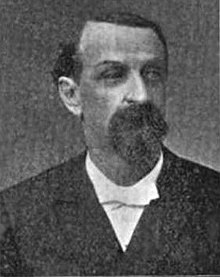Thomas Updegraff

Thomas Updegraff (April 3, 1834 – October 4, 1910) was an attorney and five-term Republican member of the U.S. House of Representatives from northeastern Iowa. His two periods of service were separated by ten years out of Congress.
Early life[]

Updegraff, a descendant of the Dutch[1] Op den Graeff family, was born in Tioga County, Pennsylvania. He attended the University of Notre Dame, then moved to Iowa.
He was the clerk of the district court of Clayton County, Iowa, from 1856 to 1860. After studying law, he was admitted to the bar in 1860 and commenced practice in McGregor, Iowa.
Political career[]
In 1878 he began to serve as a member of the Iowa House of Representatives. In November of the same year, he was elected as a Republican to the United States House of Representatives from Iowa's 3rd congressional district, which was then made up of the seven counties in Iowa's northeastern corner.[2] Two years later he was re-elected to a second term. The following year the Iowa General Assembly reapportioned the congressional districts to accommodate the addition of two additional seats, placing Updegraff's home county in a reconfigured 4th congressional district.[2] He won the Republican Party's nomination in 1882.[3] However, in the general election he was defeated by Luman Hamlin Weller of the United States Greenback Party. Updegraff had served Iowa's 3rd congressional district from March 4, 1879 to March 3, 1883.
Returning to Iowa, Updegraff was a member of the McGregor Board of Education, and the city solicitor. He was a delegate to the 1888 Republican National Convention.
In 1892, he again ran for Congress in Iowa's 4th district, winning not only the Republican nomination but also the general election (where he defeated incumbent Democrat Walter Halben Butler). He was re-elected to two more terms. However, in 1898, he was defeated in his bid for the Republican nomination by Gilbert N. Haugen, who would go on to serve seventeen consecutive terms. In all, Updegraff served the 4th congressional district from March 4, 1893 to March 3, 1899.
After Congress[]
Updegraff then returned to McGregor to resume the practice of law. He died in McGregor, and was interred there in Pleasant Grove Cemetery.
Family[]
In 1858, Updegraff married Laura A. Platt of Huron County, Ohio.[4] She died in 1865,[5] and he later married Florence Haight. They were the parents of two daughters, Elizabeth and Rachel.
References[]
- ^ Prof. William I. Hull: William Penn and the Dutch Quaker Migration to Pennsylvania (2018)
- ^ Jump up to: a b "Iowa congressional district maps, 1847-2013 Archived 2008-06-30 at the Wayback Machine," accessed 2009-04-17.
- ^ "Congressional Nominations," New York Times, 1882-07-28 at p. 5.
- ^ Price, Realto E. (1916). History of Clayton County, Iowa. 1. Chicago, IL: Robert O. Law Company. p. 408.
- ^ History of Clayton County, Iowa, p. 411.
External links[]
- United States Congress. "Thomas Updegraff (id: U000019)". Biographical Directory of the United States Congress.
- Thomas Updegraff at Find a Grave
- 1834 births
- 1910 deaths
- People from Tioga County, Pennsylvania
- People from McGregor, Iowa
- University of Notre Dame alumni
- Iowa lawyers
- Iowa Republicans
- School board members in Iowa
- Members of the Iowa House of Representatives
- Members of the United States House of Representatives from Iowa
- Republican Party members of the United States House of Representatives
- 19th-century American politicians
- 19th-century American lawyers

